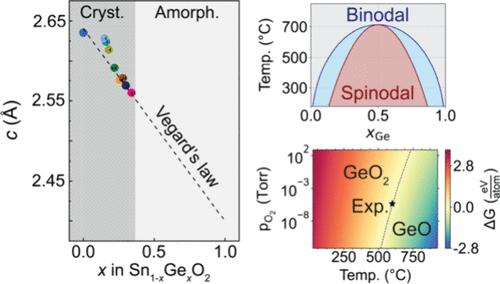金红石Sn1-xGexO2生长动力学的理论与实验研究
IF 9.1
1区 材料科学
Q1 CHEMISTRY, MULTIDISCIPLINARY
引用次数: 0
摘要
金红石GeO2及其相关材料由于其超宽带隙和双极性掺杂在大功率电子应用中的潜力而引起了人们的兴趣。本研究通过氧等离子体辅助杂化分子束外延(hMBE)研究了金红石Sn1-xGexO2薄膜的生长。在一系列生长条件下对薄膜成分和厚度进行评估,并使用密度泛函理论计算对结果进行合理化。我们发现,在600°C时,Sn1-xGexO2 /r-Al2O3 (x≤0.34)中可以成功地掺入高达34%的Ge。我们的相图计算表明,当锗浓度超过34%时,会发生spinodal分解。富锗薄膜的非晶化和GeO的挥发性抑制了富锗金红石相的形成。因此,我们推测最大限度地提高Ge含量需要更高的Ge通量和更多的氧化环境,这为Sn1-xGexO2的生长机制提供了新的见解,并为合成纯金红石型GeO2薄膜铺平了道路。本文章由计算机程序翻译,如有差异,请以英文原文为准。

Unraveling the Growth Dynamics of Rutile Sn1–xGexO2 Using Theory and Experiment
Rutile GeO2 and related materials are attracting interest due to their ultrawide band gaps and potential for ambipolar doping in high-power electronic applications. This study examines the growth of rutile Sn1–xGexO2 films through oxygen-plasma-assisted hybrid molecular beam epitaxy (hMBE). The film composition and thickness are evaluated across a range of growth conditions, with the outcomes rationalized by using density functional theory calculations. We find that up to 34% Ge can be successfully incorporated into Sn1–xGexO2/r-Al2O3 (x ≤ 0.34) at 600 °C. Our phase diagram calculations suggest that spinodal decomposition occurs at Ge concentrations exceeding 34%. However, the formation of a Ge-rich rutile phase is inhibited by amorphization of the Ge-rich film and volatility of GeO. We therefore speculate that maximizing the Ge content requires higher Ge flux and more oxidizing environments, providing insights into the growth mechanism of Sn1–xGexO2 and paving the way toward the synthesis of pure rutile GeO2 films.
求助全文
通过发布文献求助,成功后即可免费获取论文全文。
去求助
来源期刊

Nano Letters
工程技术-材料科学:综合
CiteScore
16.80
自引率
2.80%
发文量
1182
审稿时长
1.4 months
期刊介绍:
Nano Letters serves as a dynamic platform for promptly disseminating original results in fundamental, applied, and emerging research across all facets of nanoscience and nanotechnology. A pivotal criterion for inclusion within Nano Letters is the convergence of at least two different areas or disciplines, ensuring a rich interdisciplinary scope. The journal is dedicated to fostering exploration in diverse areas, including:
- Experimental and theoretical findings on physical, chemical, and biological phenomena at the nanoscale
- Synthesis, characterization, and processing of organic, inorganic, polymer, and hybrid nanomaterials through physical, chemical, and biological methodologies
- Modeling and simulation of synthetic, assembly, and interaction processes
- Realization of integrated nanostructures and nano-engineered devices exhibiting advanced performance
- Applications of nanoscale materials in living and environmental systems
Nano Letters is committed to advancing and showcasing groundbreaking research that intersects various domains, fostering innovation and collaboration in the ever-evolving field of nanoscience and nanotechnology.
 求助内容:
求助内容: 应助结果提醒方式:
应助结果提醒方式:


